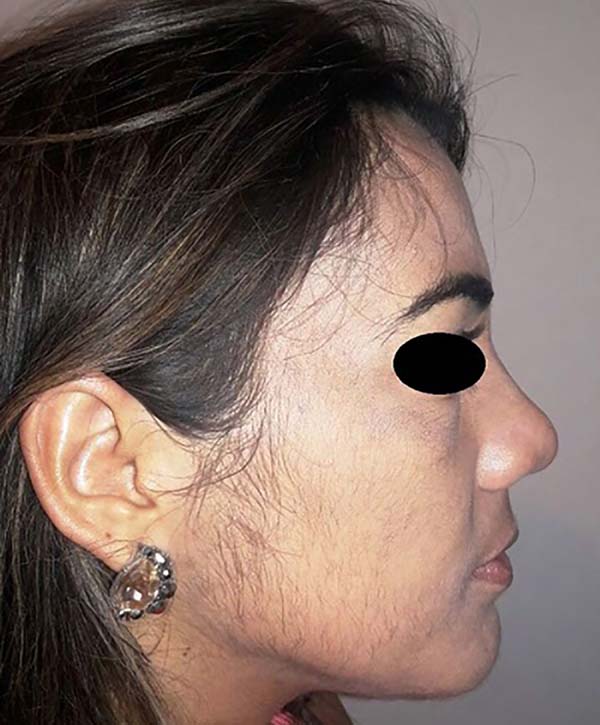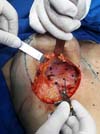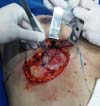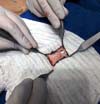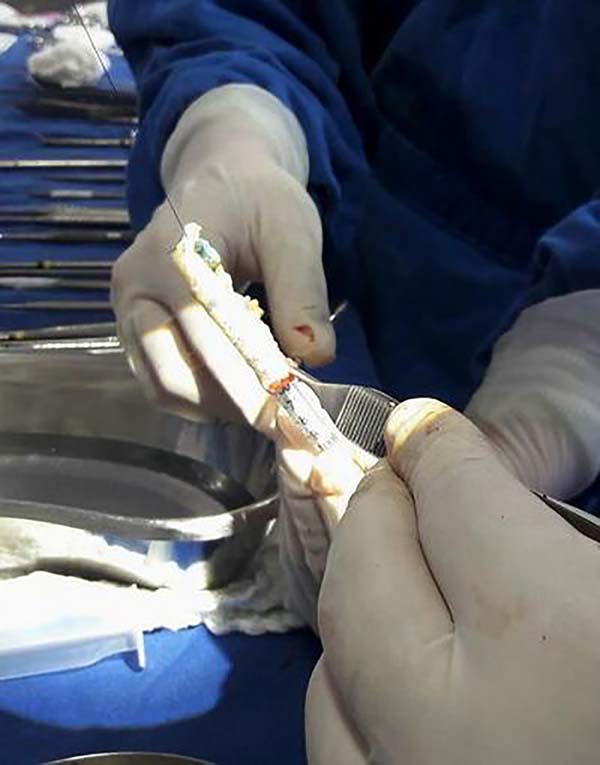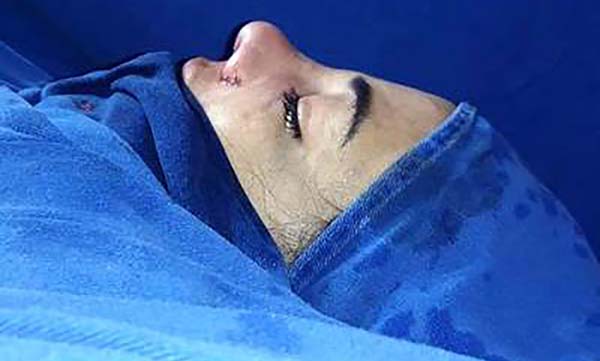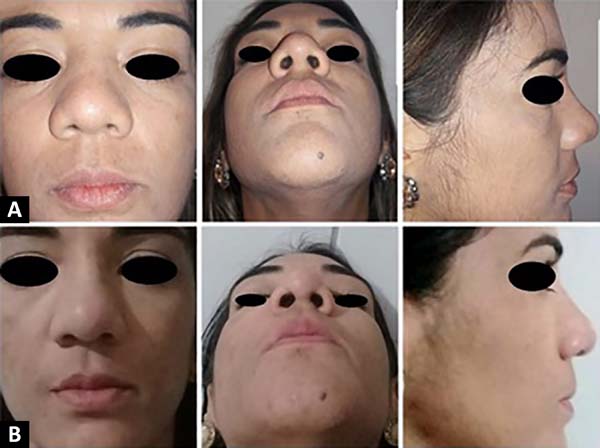INTRODUCTION
Increasing the nasal dorsum in rhinoplasty demands good preoperative planning, intraoperative
execution, and postoperative care. Synthetic, autologous, and homologous materials,
mainly cartilage, have been used for this purpose1,2.
The use of cartilage has been widely studied in recent decades. The graft is obtained
from septal, conchal, or costal cartilage and can be used and shaped in various ways,
surviving as a living tissue with a low occurrence of absorption, extrusion, and infection.
In addition, it provides almost no stimulus to the immune response1,3.
Minced cartilage is a versatile option for filling and camouflaging cartilaginous
grafting. The process is performed manually to obtain cubes smaller than 1 mm2. The use of fascia to integrate the chopped cartilage aims to improve graft contour
and reduce palpability and dispersibility; the use of temporal fascia for this purpose
is most frequently described1,3.
Here we report the case of a patient who underwent bilateral rhinoplasty and mastopexy
with prostheses. In this case, we used fragments of major chest fascia to integrate
the chopped costal cartilage using a technique similar to that described by Erol in
20004.
CASE REPORT
R.K.S.M., a 35-year-old patient, underwent structured rhinoplasty with increased dorsum
and mastopexy with prostheses on January 26, 2018 (Figure 1).
Figure 1 - Photograph taken preoperatively.
Figure 1 - Photograph taken preoperatively.
A bilateral incision was made in the mammary sulcus with dissection to the right up
to the pectoralis major muscle and the collection of a 4 cm × 4 cm portion of its
fascia (Figures 2-5).
Figura 2 - Fascia of the right pectoralis major muscle.
Figura 2 - Fascia of the right pectoralis major muscle.
Figure 3 - Marking of the 4 cm × 4 cm pectoralis major fascia fragment.
Figure 3 - Marking of the 4 cm × 4 cm pectoralis major fascia fragment.
Figure 4 - Excision of the pectoralis fascia fragment.
Figure 4 - Excision of the pectoralis fascia fragment.
Figure 5 - Fragment of the right pectoralis major fascia measuring 4 cm × 4 cm.
Figure 5 - Fragment of the right pectoralis major fascia measuring 4 cm × 4 cm.
As described by Robotti and Penna5, the fibers of the pectoralis major muscle are divulgated but not separated. The
sixth costal arch is accessed and bone and cartilage are differentiated through color
discrimination and needle palpation. Thus, an entire fragment of cartilage was collected
and the perichondrium was left intact. The wound is filled with saline solution, the
integrity of the pleura is confirmed by ventilatory pressure by the anesthesiologist,
and the planes are closed.
The collected fascia was wrapped in a 1-mL syringe and one of its extremities was
sutured, thus creating an open bag in one of its extremities as in the Turkish delight technique4. Through the open end, the small cylindrical bag was filled with the costal cartilage
manually minced into small cubes. The open end was then sutured (Figure 6).
Figure 6 - Preparation of the cylindrical bag of pectoralis fascia filled with chopped costal
cartilage using a 1-mL syringe.
Figure 6 - Preparation of the cylindrical bag of pectoralis fascia filled with chopped costal
cartilage using a 1-mL syringe.
The cylinder of the chopped cartilage involved by the fascia was positioned on the
patient’s nasal dorsum, promoting its increase in size (Figure 7). Mastopexy was performed with the inclusion of prostheses. The surgery proceeded
uneventfully, and the patient was discharged on the 1st postoperative day in excellent general condition. In outpatient follow-up, we observed
the stability of the graft on the nasal dorsum 17 months after surgery (Figure 8).
Figure 7 - Photograph taken immediately postoperative.
Figure 7 - Photograph taken immediately postoperative.
Figure 8 - A:Photographs taken preoperatively. B: Photographs taken at 17 months postoperative.
Figure 8 - A:Photographs taken preoperatively. B: Photographs taken at 17 months postoperative.
DISCUSSION
Deep temporal fascia is frequent in primary and secondary rhinoplasty because it has
good flexibility and thickness, a low absorption rate, and is resistant to infection.
Thus, the fascia can be used to cover the nasal osteocartilaginous framework and prevent
irregularities from becoming apparent, especially in patients with thin skin. It is
also used for nasal back augmentation and to better define the tip5.
The use of fascia involving chopped cartilage also brings other benefits. It has already
been demonstrated that the chopped parts coated by fascia coalesce into a mass with
an organized architecture and chondrocytes that present normal metabolic activity.
Thus, the graft has adequate durability and stability2.
Collecting temporal fascia is a simple procedure, but it requires a second incision
in a separate surgical field, which adds time and morbidity to the surgery as well
as a new scar. There are reports of the use of fascia lata for the same purpose, but
this has relative disadvantages, such as less flexibility. The occurrence of alopecia
close to a temporal surgical incision was also mentioned6.
The fascia of the rectus abdominis muscle is comparatively thicker and less compliant
in addition to being important to abdominal wall integrity and contractility. Studies
by As’adi et al. in 20149 and Cerkes and Basaran in 201610, which used fascia of the rectus abdominis muscle and chopped cartilage for increased
nasal dorsum, demonstrated good long-term graft viability. However, further studies
are needed on rectus abdominis muscle stability and contraction7,8,9,10.
The major chest fascia, a thin layer of connective tissue that covers the major chest
muscle, is histologically and macroscopically similar to the temporal fascia. It is
routinely dissected and removed in radical oncological mastectomies. No specific surgical
maneuvers are necessary to avoid dehiscence of the pectoralis major muscle nor are
there any other complications. Furthermore, removal of the major chest fascia in mastectomies
does not influence postoperative bleeding or seroma formation7.
In patients in need of nasal dorsal augmentation or revision rhinoplasty, autologous
costal cartilage is usually collected, as good quality cartilage is required for nasal
augmentation or structuring. Costal cartilage has great advantages over auricular
cartilage with respect to quantity and quality7,8.
To remove the cartilage when the fifth, sixth, or seventh costal arch is chosen, the
major pectoral fascia is accessed through the same incision. In this way, one part
of the fascia can be collected for use in rhinoplasty, thus avoiding another surgical
incision and its inherent morbidity7. In the present case, the patient underwent bilateral mastopexy and rhinoplasty.
Through the mastopexy incision, it is possible to collect the pectoral fascia and
costal cartilage.
CONCLUSION
The collection and use of chest fascia in cases requiring costal cartilage eliminates
the need for another incision and scar in addition to reducing surgical morbidity
and time. The fascia of the pectoralis major muscle is a good alternative for use
in rhinoplasty.
COLLABORATIONS
|
CMV
|
Conceptualization, Methodology, Visualization, Writing - Original Draft Preparation,
Writing - Review & Editing
|
|
LSC
|
Analysis and/or data interpretation, Writing - Original Draft Preparation
|
|
ASM
|
Writing - Original Draft Preparation
|
|
MV
|
Analysis and/or data interpretation, Writing - Original Draft Preparation
|
|
DSOA
|
Writing - Original Draft Preparation
|
|
KRO
|
Writing - Original Draft Preparation
|
|
WCNBP
|
Final manuscript approval, Realization of operations and/or trials, Supervision
|
|
SMC
|
Supervision
|
REFERENCES
1. Baser B, Kothari S, Thakur M. Diced cartilage: na effective graft for posttraumatic
and revision rhinoplasty. Indian J Otolaryngol Head Neck Surg. 2013 Aug;65(Suppl 2):356-359.
DOI: https://doi.org/10.1007/s12070-012-0525-6
2. Park P, Jin HR. Diced cartilage in fascia for major nasal dorsal augmentation in Asians:
a review of 15 consecutive cases. Aesth Plast Surg. 2016 Dec;40(6):832-839. DOI: https://doi.org/10.1007/s00266-016-0698-6
3. Bussi M, Palonta F, Toma S. Grafting in revision rhinoplasty. Acta Otorhinolaryngol
PMID: 23853414Ital. 2013;33(3):183-189.
4. Erol OO. The Turkish delight: a pliable graft for rhinoplasty. Plast Reconstr Surg.
2000 May;105(6):2229-41. DOI: https://doi.org/10.1097/00006534-200005000-00051
5. Park SW, Kim JH, Choi CY, Jung KH, Song JW. Various applications of deep temporal
fascia in rhinoplasty. Yonsei Med J. 2015 Jan;56(1):167-174. DOI: https://doi.org/10.3349/ymj.2015.56.1.167
6. Hodgkinson DJ, Valente V. The versatile posterior auricular fascia in secondary rhinoplasty
procedures. Aesth Plast Surg. 2017 Aug;41(4):893-897. DOI: https://doi.org/10.1007/s00266-017-0824-0
7. Xavier R. Pectoralis major fascia in rhinoplasty. Aesth Plast Surg. 2015 Mar;39(3):300-305.
DOI: https://doi.org/10.1007/s00266-015-0461-4
8. Daniel RK, Sajadian A. Secondary rhinoplasty: management of the overresected dorsum.
Facial Plast Surg. 2012 Aug;28(4):417-26. DOI: https://doi.org/10.1055/s-0032-1319840
9. As’adi K, Salehi SH, Shoar S. Rib diced cartilage-fascia grafting in dorsal nasal
reconstruction: a randomized clinical trial of wrapping with rectus muscle fascia
vs deep temporal fascia. Aesthet Surg J. 2014 Aug;34(6):NP21-31. PMID: 24879882 DOI:
https://doi.org/10.1177/1090820X14535078
10. Cerkes N, Basaran K. Diced Cartilage Grafts Wrapped in Rectus Abdominis Fascia for
Nasal Dorsum Augmentation. Plast Reconstr Surg. 2016 Jan;137(1):43-51. PMID: 26368329
DOI: https://doi.org/10.1097/PRS.0000000000001876
1. Hospital Felício Rocho, Belo Horizonte, MG, Brazil.
2. Santa Casa de Misericórdia, Belo Horizonte, MG, Brazil.
Corresponding author: Camila Matos Versiani Rua Platina, 56, Apto 201, Belo Horizonte, MG, Brazil. Zip Code: 30411-092 E-mail:
camilamversiani@hotmail.com
Article received: October 25, 2018.
Article accepted: January 22, 2019.
Institution: Hospital Felício Rocho, Belo Horizonte, MG, Brazil.
Conflicts of interest: none.



